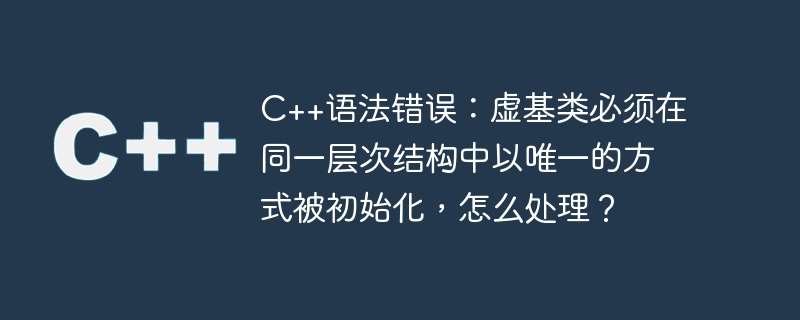Home >Backend Development >C++ >C++ syntax error: virtual base classes must be initialized in a unique way in the same hierarchy, how to deal with it?
C++ syntax error: virtual base classes must be initialized in a unique way in the same hierarchy, how to deal with it?
- PHPzOriginal
- 2023-08-22 13:51:421154browse

C, as an object-oriented programming language, is widely used in software development. Virtual base class is an important concept in C and is often used in situations such as multiple inheritance and diamond inheritance to ensure the uniqueness and consistency of data members. However, in the process of using virtual base classes, we often encounter the error message "Virtual base classes must be initialized in a unique way in the same hierarchy." This article will introduce the method to solve this error.
First of all, we need to understand what a virtual base class is. A virtual base class is an abstract class that only provides a public interface for other classes and has no actual data members. When a class is derived from multiple classes, and one or more of these classes are derived from the same virtual base class, the virtual base class only needs to be initialized once to ensure the uniqueness and consistency of the data members.
However, in actual programming, sometimes we use virtual base classes in multi-level inheritance, and some problems will occur. For example, the following example:
class A
{
public:
int a;
};
class B: virtual public A
{
public:
int b;
};
class C: virtual public B
{
public:
int c;
};
class D: public B, public C
{
public:
int d;
};In this example, we define an A class, a B class, a C class and a D class. Among them, classes B and C both inherit from class A and are also the base classes of class D. Virtual inheritance is used in classes B and C to ensure that there is only one instance of class A in class D.
However, we will encounter the following error message when compiling:
error: cannot allocate an object of abstract type 'D' note: because the following virtual functions are pure within 'D': note: virtual void A::foo()
This error message indicates that class D cannot be assigned as an abstract type because there is a pure virtual function foo in class A () is not defined. However, we can find that after defining the virtual base class, we did not initialize the virtual base class in class D, causing the constructor of class A to be unable to be called correctly and causing an error.
So, how to solve this error? One possible method is to explicitly call the constructor of the virtual base class A in the constructor of class D. The modified D class is as follows:
class A
{
public:
int a;
};
class B: virtual public A
{
public:
int b;
};
class C: virtual public B
{
public:
int c;
};
class D: public B, public C
{
public:
int d;
D(int i)
:A(),B(),C(),d(i)
{
}
};As you can see, in the constructor of class D, we use the initialization list to initialize the three virtual base classes A, B and C. This avoids the problem of virtual base class initialization and solves the error.
In summary, virtual base class is a very important concept in C, but when using it, you need to pay attention to the initialization problem in multi-layer inheritance. Some error prompts do not directly point to the virtual base class itself, but are related to the virtual base class, so we need to carefully analyze the error prompts and eliminate the errors in time. The above is the method to solve "virtual base classes must be initialized in a unique way in the same hierarchy". I hope it will be helpful to readers.
The above is the detailed content of C++ syntax error: virtual base classes must be initialized in a unique way in the same hierarchy, how to deal with it?. For more information, please follow other related articles on the PHP Chinese website!

